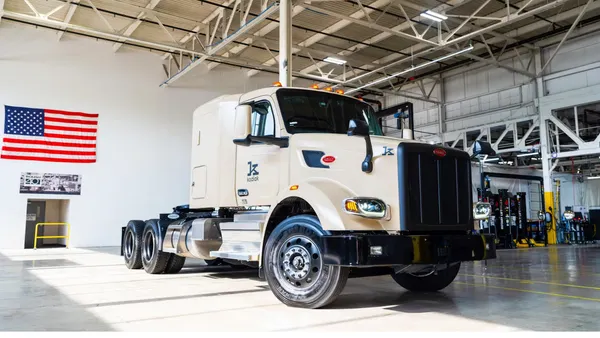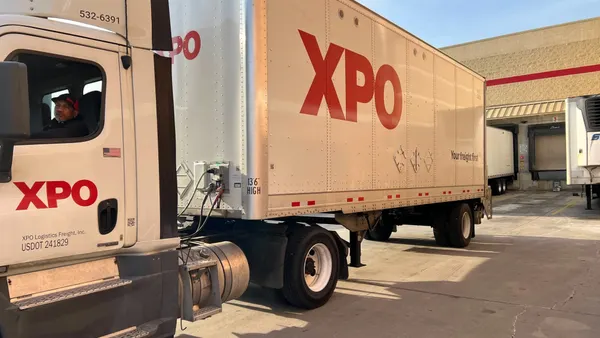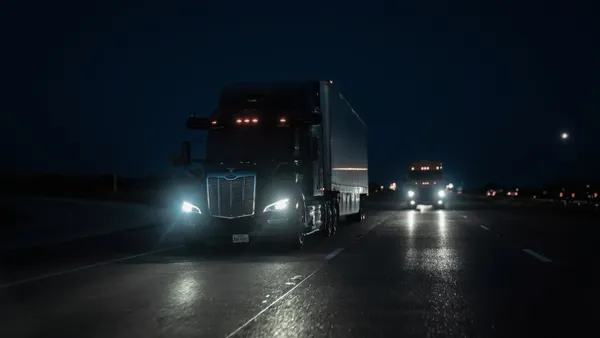Artificial intelligence (AI) is taking over many mundane tasks in the trucking and freight industries, freeing up time for humans to do other work. But it's still early in the ballgame, experts told Transport Dive.
Trucking is dependent upon human expertise, from driving to computer programming to managing fleets. AI must consistently learn to be effective. The technology is slowly making many of the decisions normally made by brokers, drivers, mechanics and fleet managers.
Eventually, intelligent machines will take the wheel, with companies such as TuSimple and Plus.ai lining up to prove their AI can guide freight across the nation. Machine learning is the main technology behind driverless trucks, but before autonomous trucks are widely implemented, AI will likely have to prove itself in billing and routing.
AI augments manpower
Coyote Logistics, a proponent of AI and technology, launched the technology further into routing on July 15, when it said it would add dynamic route optimization (DRO) to its services offered. The machine-learning algorithm guides drivers to and from home bases by combing over factors such as region, drivers' hours, costs, load attributes, average load and unload times. Coyote said it then mixes the data over open and available loads, reducing idle times and deadheading. Coyote promised carriers consistent weekly miles, even given volatility, in a range of 2,100 to 2,700 miles.
Coyote is keen on AI. In September, it released a study, "Technology + Humanity: Striking the Balance in Your Business," in which supply chain managers said the optimal balance between technology and human expertise was 60-40, in favor of the machines. The view of Coyote officials was technology such as AI strengthened manpower.
AI is growing inside the transport industry. In 2017, the global market for transportation-related AI was between $1.2 to $1.4 billion, according to research done by the International Finance Corp. (IFC) of the World Bank Group. North America had the largest share of the AI transport market, at 44%, the IFC found. The IFC said AI could grow globally to a market valued between $3.1 billion to $3.5 billion by 2023.
Major fleets took notice a few years ago. At Schneider, the volume of requests and the size of tasks convinced it to look to AI, according to Brian Stuelpner, the fleet's VP of strategy, planning and architecture. The company began using AI to improve productivity and the customers' experiences.
One frequent task that Schneider realized it could farm out to the machines was finding freight for customers or shippers who wanted to know the freight's real-time location. Giving it to AI would free up customer service representatives, Stuelpner told Transport Dive. So Schneider made freight location upon request one of the first AI tasks. If customers or shippers contacted the carrier, and the AI detected it was a "where's my freight?" question, the machines could answer within seconds.
"There's so much data available today and it's only growing."

Brian Stuelpner
Schneider VP of strategy, planning and architecture
Schneider's AI has been operative for four years, and is used for customer service and recommending loads to clients. Stuelpner said the surface has only been scratched, and one of the reasons is technology in general is providing fleets with more and more data — on maintenance issues, routes, drivers' performances and more.
Many fleets have said the data is too large for humans to comb over, yet it must be analyzed. Handing the data off to AI to make decisions is the logical and necessary step, experts say.
"There's so much data available today and it's only growing," Stuelpner said.
Documenting AI
Another data-rich environment is freight documentation. Every year, billions of documents fly around the freight process, leaving carriers, brokers, factoring companies and forwarders with a lot of paperwork to track and file.
Many firms are handing off document filing, scanning and approvals to the machines, according to Matt Bernstein, CEO of HubTran, which focuses on using AI and automation for "back office" work. By that, Bernstein means transactional work related to documents that has been traditionally difficult to automate or run via AI.
"What's happening is that the machine is learning organically by seeing all these different documents, and seeing how these companies are using these documents."

Matt Bernstein
CEO, HubTran
Bernstein said the software used by HubTran's customers is AI already trained on what to look for in documents, as varied as they can be. There is no need for the AI to know particular types of formatted document, which would be nearly impossible in the wide world of freight. It is here where Bernstein differentiates AI from automation: Unlike an automated computer program, AI can see or sense what it needs on a page of information, much like face-recognition software. The AI looks for what it needs to complete the transaction and then files the paperwork digitally.
"What's happening is that the machine is learning organically by seeing all these different documents, and seeing how these companies are using these documents," said Bernstein.
But just before AI's work is done, some HubTran clients prefer a final "button push," in which a worker reviews a summary on-screen and clicks on the final approval, Bernstein said. But other clients let HubTran's AI to handle the whole process unless a red flag is thrown up — "management by exception," Bernstein said.
Steve Viscelli, a professor at the University of Pennsylvania and a senior fellow at the Kleinman Center for Energy Policy, told Transport Dive that AI has one major problem right now: It's a big capital expenditure in an industry where margins can be tight.
Widespread adoption of AI-driven trucks?
AI comes with some other problems beyond cost. Getting the system trained and then operational takes up a lot of time. On the issue of autonomous trucks, the issues seem even deeper.
Viscelli said he has noted how relatively soon companies such as TuSimple say they will have fully autonomous trucks ready for use.
TuSimple entered into a partnership with Navistar to develop L4 autonomous trucks. Navistar's co-production could begin in 2024.
TuSimple operates 40 autonomous trucks now, in Arizona and Texas, with plans for California in 2022. Those trucks, however, have a human inside the cab. TuSimple plans to showcase completely driverless automated trucks in 2021.
But Viscelli told Transport Dive there is a lot to think about regarding widespread usage of autonomous trucks powered by AI — cost, bad weather and road-salt wear, to name a few curve balls, said Viscelli.
"I think the real-world applications are more complicated and lower margin than a lot of the developers assume," said Viscelli. "You've got to be reliable and cost-competitive. It's really tough out there for trucking companies."
Viscelli said if AI works, trucking firms will adopt it, just as fleets used satellite-linked communications early on. But he has heard developers talk about wide L4 use as "monumental" and a "giant leap." Still, AI will arrive fully, sooner or later, to drive most, if not all, the trucks.
"I think we'll get there but it will take longer than people think," said Viscelli.
On that, Stuelpner agrees.
"It feels like we're still in the early innings of this," said Stuelpner.










